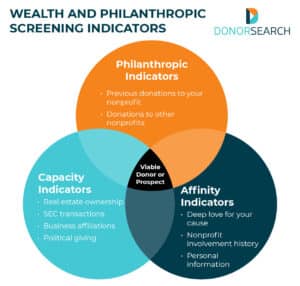
Imagine your nonprofit is creating its annual fundraising plan. You know you’ll need to get a wide range of supporters on board to increase your monthly donation revenue, secure the major gifts necessary to get your upcoming capital campaign off the ground, and reach your year-end fundraising goal. But how are you going to find all of these donors?
This is where prospect research comes in. DonorSearch’s prospect research guide defines the term as “a technique used by nonprofit fundraisers, major gift officers, and development teams to identify high-impact donors within and beyond an organization’s current donor pool. Through this process, nonprofits gather an immense amount of data…about donors’ backgrounds, past giving histories, wealth indicators, philanthropic motivations, and more.”
To help you effectively leverage this technique at your nonprofit, this guide will walk through four proven ways to boost your prospect research efforts, including how to:
- Set Clear Goals Before You Begin
- Leverage the Right Prospect Research Tools
- Consider More Factors Than Just Prospect’s Wealth
- Analyze and Apply Your Collected Data
Whether you’re just getting started with prospect research or you’ve gone through the process before but see areas for improvement, these tips will help you refine your strategy and find the donors you need to further your organization’s mission. Let’s dive in!
1. Set Clear Goals Before You Begin
You’ve probably heard the saying, “Begin with the end in mind,” which is very true when it comes to prospect research. Knowing what you want to accomplish before you get started will help guide your efforts so you can find better prospects more quickly and easily.
The overarching goal for your prospect research efforts might look something like:
- Finding major donors to fund particular projects, programs, or campaigns.
- Growing your nonprofit’s mid-level donor program.
- Forming business relationships that will help you take better advantage of corporate philanthropy opportunities like sponsorships and grants.
- Engaging your current donor base more effectively with tailored opportunities for deeper involvement with your mission.
Once you have a general objective in mind, make it more actionable using the SMART framework—specific, measurable, attainable, relevant, and time-based. For example, you could reshape the first goal in the list above to read, “Through our prospect research efforts, we plan to find five major donor prospects for our upcoming capital campaign within the next three months.”
This goal is specific about what you want to achieve, includes a metric (five prospects) and a time frame (the next three months), and relevant to your organization’s fundraising plan. To determine whether it’s attainable, look back at your past prospect research efforts and ask a fundraising consultant to help you decide if your nonprofit is equipped to reach that goal.
2. Leverage the Right Prospect Research Tools
In order to accomplish your organization’s prospect research goals, you’ll need the right resources on your side. There are a variety of software solutions available to help you identify and screen potential donors, including:
- Your nonprofit’s constituent relationship management (CRM) system. High-impact donors may be hiding in your current supporter base. Use your CRM to learn more about your current donors and determine whether they would be a good prospect themselves or know another prospect they could introduce you to.
- SEC and FEC records. These government records, which track investments and political contributions respectively, can show you which of your current and potential donors would be able and willing to make a significant donation.
- Prospect research databases. These specialized platforms can provide your organization with additional details about prospects’ giving histories, business connections, real estate ownership, stock holdings, and more.
- AI solutions. Machine learning tools are useful for analyzing your prospect research data and segmenting prospects using predictive modeling.
- Matching gift tools. These solutions can help you make the most of your donors’ contributions by finding out which of their employers will match gifts to your nonprofit.
Additionally, don’t underestimate the value of a simple internet search! Once you identify a prospect using the tools above, browse their social media profiles and see what other information you can find about them online to gain more insight into who they are and what they value.
3. Consider More Factors Than Just Prospects’ Wealth
When discussing prospect research, you might hear the term “wealth screening.” The process this term generally describes is a key aspect of prospecting in which you examine indicators of a potential donor’s wealth to determine whether they have the financial capacity to make a significant donation to your nonprofit.
However, this research alone isn’t enough to know whether you’ve found a possible donor. You’ll need to conduct both wealth and philanthropic screening together to understand a prospect’s true giving potential.
With this more comprehensive type of screening, you’ll look for markers that fall into the following three categories:

- Capacity indicators such as real estate ownership, SEC transactions, business affiliations, and political giving.
- Philanthropic indicators including previous donations to your organization or other nonprofits.
- Affinity indicators like a deep love for your cause, a history of involvement with nonprofits through activities such as volunteering or board service, and other personal details.
When a potential donor exhibits all three types of markers, you’ll know that you’ve found a viable prospect who would be both able and willing to contribute to your organization.
4. Analyze and Apply Your Collected Data
The information you find through prospect research should lay the foundation for your donor relations efforts. According to NXUnite, “donor relations consists of…the efforts that a nonprofit organization puts into building relationships with its donors and making them feel seen and valued as people.”
Once you’ve found viable prospects, here are some ways to start building relationships with them:
- Get to know them as individuals. Meet with your prospects one on one and learn about their families, careers, hobbies, and interests. Take note of key details and bring them up in subsequent conversations. Asking a potential donor how their recent trip to Hawaii was or whether their son Alex’s junior year of high school is going well shows that you were listening and care about what is going on in their lives.
- Communicate regularly. In between meetings with prospects, follow up with them and keep them posted on your organization’s activities. Make sure to use their preferred communication method—some donors appreciate phone calls, while others are more likely to respond to text messages or emails, for example.
- Offer tailored opportunities for involvement. Look at your potential donors’ nonprofit engagement histories and interests to suggest activities at your organization that they might enjoy, such as volunteering, attending events, or consulting on upcoming projects.
When the time comes to make your main fundraising ask, use your prospect research data and what you’ve learned during the relationship-building process to suggest an amount and designation for the gift that you’re confident the potential donor will be receptive to.
Prospect research might seem complicated at first, but with a clear plan and the right tools, it can greatly benefit your nonprofit’s fundraising efforts. Once you’ve found a donor with the capacity, affinity, and philanthropic inclination to make an impact for your mission, use the information you’ve found to build a solid relationship that will naturally lead to a donation request and long-term support for your mission.
 Author: Sarah Tedesco
Author: Sarah Tedesco
Sarah Tedesco is the Executive Vice President of DonorSearch, a prospect research and wealth screening company that focuses on proven philanthropy. Sarah is responsible for managing the production and customer support department concerning client contract fulfillment, increasing retention rate and customer satisfaction. She collaborates with other team members on a variety of issues including sales, marketing and product development ideas.
